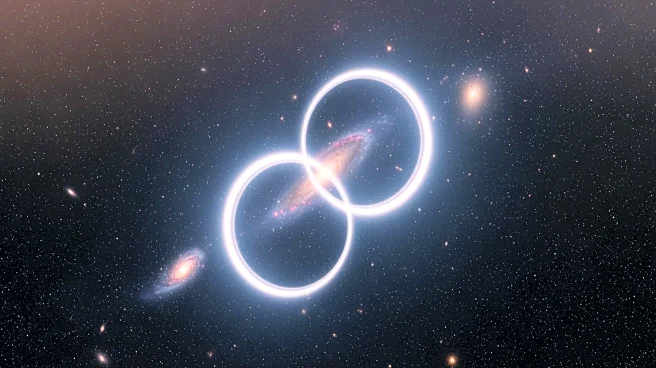What's Happening?
Astronomers have identified a new 'odd radio circle' (ORC), marking it as the most distant and powerful ORC discovered to date. This discovery was made by researchers at the University of Mumbai, India,
with assistance from citizen scientists and the world's largest low-frequency radio telescope. ORCs are mysterious rings surrounding distant galaxies, detectable only through radio telescopes. The latest ORC consists of two intersecting rings, a rare occurrence. Previous studies suggested ORCs might result from shockwaves due to merging supermassive black holes or galaxies. However, the new findings propose that these phenomena could be linked to 'superwind' emanating from their host galaxies.
Why It's Important?
The discovery of these powerful ORC twins could provide significant insights into the evolution of galaxies and black holes. Understanding ORCs may reveal how cosmic structures are shaped by black hole jets and winds, offering clues about the co-evolution of galaxies and black holes. The involvement of citizen scientists in this discovery underscores the importance of human pattern recognition in scientific research, even amidst advancements in machine learning. This finding expands the understanding of exotic plasma structures in the universe, potentially influencing future astronomical research and theories.
What's Next?
Further research is likely to focus on understanding the mechanisms behind ORCs and their formation. Scientists may conduct more detailed observations and simulations to explore the role of superwinds and other cosmic phenomena in shaping these structures. The collaboration between professional astronomers and citizen scientists may continue to play a crucial role in uncovering new cosmic phenomena, potentially leading to more discoveries in the field of radio astronomy.
Beyond the Headlines
The discovery of ORC twins highlights the potential for citizen science to contribute to major scientific breakthroughs. It also raises questions about the nature of cosmic phenomena and the forces shaping the universe. As researchers delve deeper into the study of ORCs, they may uncover new aspects of cosmic evolution, challenging existing theories and expanding the boundaries of astronomical knowledge.













